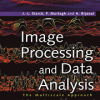Free Online Productivity Tools
i2Speak
i2Symbol
i2OCR
iTex2Img
iWeb2Print
iWeb2Shot
i2Type
iPdf2Split
iPdf2Merge
i2Bopomofo
i2Arabic
i2Style
i2Image
i2PDF
iLatex2Rtf
Sci2ools
Book
Image processing and data analysis: The multiscale approach
"There is a very large literature on the theoretical underpinnings of the
wavelet transform. However, theory must be complemented with a significant
amount of practical work. Selection of method, implementation,
validation of results, comparison with alternatives – these are all centrally
important for the applied scientist or engineer. Turning theory into practice
is the theme of this book. Various applications have benefited from the
wavelet and other multiscale transforms. In this book, we describe many
such applications, and in this way illustrate the theory and practice of such
transforms. We describe an ‘embedded systems’ approach to wavelets and
multiscale transforms in this book, in that we introduce and appraise appropriate
multiscale methods for use in a wide range of application areas."
Deconvolution | Disparity Analysis | Geometric Registration | Image Compression | Image Processing | Multiresolution | Object Detection | Remote Sensing | Wavelet Transform | Wavelets |
Related Content
| Added | 04 Mar 2009 |
| Updated | 04 Mar 2009 |
| Authors | Jean-Luc Starck, Fionn Murtagh, Albert Bijaoui |
Table of contents
1.1 Multiscale methods
1.1.1 Some perspectives on the wavelet transform
1.1.2 The wavelet transform and the Fourier transform
1.1.3 Applications of the wavelet transform
1.2 The continuous wavelet transform
1.2.1 Definition
1.2.2 Properties
1.2.3 The inverse transform
1.3 Examples of wavelet functions
1.3.1 Morlet’s wavelet
1.3.2 Mexican hat
1.3.3 Haar wavelet
1.4 The discrete wavelet transform
1.4.1 Multiresolution analysis
1.4.2 Mallat’s horizontal and vertical analyses
1.4.3 Non-dyadic resolution factor
1.4.4 The `a trous algorithm
1.4.5 Pyramidal algorithm
1.4.6 Scaling functions with a frequency cut-off
1.4.7 Discussion of the wavelet transform
1.5 Multiresolution and median transform
1.5.1 Multiresolution median transform
1.5.2 Pyramidal median transform
1.5.3 Iterative pyramidal median transform
1.5.5 Conclusion on multiscale median transforms
1.6 Multiresolution and mathematical morphology
1.6.1 Multiresolution
1.6.2 Pyramidal morphological transform
2.1 Noise modeling
2.1.1 Definition of significant coefficients
2.1.2 Gaussian noise
2.1.3 Poisson noise
2.1.4 Gaussian and Poisson noise
2.1.5 Poisson noise with few photons or counts
2.1.6 Other types of noise
2.2 Multiresolution support
2.2.1 Definition
2.2.3 Algorithm support and noise
2.3 Filtering
2.3.2 Wiener-like filtering in wavelet space
2.3.3 Hierarchical Wiener filtering
2.3.4 Adaptive filtering
2.3.5 Examples
2.4 Multiresolution image comparison
3.1 Introduction to deconvolution
3.2 Regularization using multiresolution support
3.2.1 Noise suppression based on the wavelet transform
3.2.3 Regularization of Van Cittert’s algorithm
3.2.4 Regularization of the one-step gradient method
3.2.5 Regularization of the Richardson-Lucy algorithm
3.2.6 Convergence
3.2.7 Examples from astronomy support
3.3 Multiscale entropy and image restoration
3.3.2 Formalism of maximum entropy multiresolution
3.3.3 Deconvolution using multiscale entropy
3.3.4 Experiments
3.3.6 Conclusion on multiscale entropy and restoration
3.4 Image restoration for aperture synthesis
3.4.2 CLEAN and wavelets
3.4.3 Experiment
3.4.4 Observations of two evolved stars
3.4.5 Conclusion on interferometric data deconvolution
4.1 Analysis of 1D signals: spectral analysis
4.1.1 Spectral analysis
4.1.2 Noise determination and detection criteria
4.1.3 Simulations
4.1.5 Band extraction
4.1.6 Continuum estimation
4.1.7 Optical depth
4.1.8 The multiresolution spectral analysis algorithm
4.2 Wavelets and multivariate data analysis
4.2.1 Wavelet regression in multivariate data analysis
4.3 The Kohonen map in wavelet space
4.4 Multiresolution regression and forecasting
4.4.3 Dynamic recurrent neural network architecture
4.4.4 Combining neural network outputs
5.1 Image distortions
5.1.1 Geometrical distortions
5.1.2 Radiometrical distortions
5.2 Geometrical image registration
5.2.1 Deformation model
5.2.2 Image correction
5.3 Ground control points
5.4 Registration using the wavelet transform
5.5 Application
5.5.1 SPOT data
5.5.2 MSS data
5.5.3 SPOT versus MSS data
5.5.4 SPOT with different imaging directions
5.5.5 Astronomical image registration
5.6 Error analysis
5.7 Conclusion on registration
6.1 Definitions
6.1.1 Disparity
6.1.2 Matching
6.1.3 Extraction of ground control points
6.2 Disparity mapping
6.2.1 Kriging
6.2.2 Variogram
6.2.3 Kriging as an interpolator
6.3 Disparity mapping with the wavelet transform
6.4 Image registration
6.5 Application to real images
6.6 Conclusion on disparity analysis
7.1 Pyramidal median transform and compression
7.1.1 Compression method
7.1.2 Quantized multiresolution coefficients
7.1.3 Quadtree and Huffman encoding
7.1.4 Noise compression
7.1.5 Image decompression
7.2 Examples and assessments
7.3 Image transmission over networks
7.4 Conclusion on image compression
8.1 The problem and the data
8.2 Median transform and Minkowski operators
8.3 Conclusion on astronomical object detection
8.4 Clustering in point patterns
8.4.2 Example 2: diffuse rectangular cluster
8.5 Conclusion: cluster analysis in constant time
9.1 Artificial vision and astronomical images
9.2 Object definition in wavelet transform space
9.2.1 Choice of a wavelet transform algorithm
9.2.2 Bases of object definition
9.2.3 Significant wavelet coefficients
9.2.4 Scale-by-scale field labeling
9.2.5 Interscale connection graph
9.2.6 An object as a tree
9.2.7 Object identification
9.3 Partial reconstruction
9.3.1 The basic problem
9.3.2 Choice of the scale number
9.3.3 Reconstruction algorithm
9.3.4 Numerical experiments
9.4 Applications to a real image
9.4.1 Multiscale method
9.4.2 INVENTORY method
9.4.3 Comments
9.5 Vision models and image classes
A.1 Mean and variance expansions
A.2 Determination of centered moments
A.3 Study of the expansions for the variance
A.4 Variance-stabilizing transformation Comments (0)



